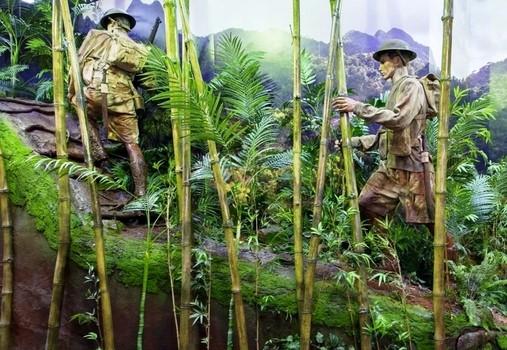
A 1:1 scale diorama showing Australian patrol advancing up the Kokoda Trail in light fighting order circa August 1942. This diorama is the central feature in the World War 2 Gallery - South West Pacific area. Soldiers are depicted still wearing khaki uniforms from North Africa campaign including shorts. Details include helmet, No 4 .303 rifles, small pack and fighting order. A Japanese "Woodpecker" machine gun is shown abandoned beside the track. Dimensions are L 7 metres W 2 metres H 4 metres. The “Woodpecker” relic was retrieved from New Guinea by the formerly Perth based 22 Construction Squadron.
The Kokoda Trail linked Ower's Corner, approximately 40 km north-east of Port Moresby to the village of Kokoda and its airstrip on the northern side of the Owen Stanley mountain range. From there trails continued to the river crossing at Wairopi and on to the settlements of Buna, Gona and Sanananda on the north coast. The village of Kokoda stood on the northern side of the main range and was the site of the only airfield between Port Moresby and the north coast.
After being repulsed at the battle of the Coral Sea, the Japanese saw the Kokoda Trail as a route to capture Port Moresby. After landings at Gona on 21 July 1942, a full-scale offensive developed., the Australian force was unable to hold back the Japanese. Beginning as a fighting withdrawal, delaying actions were fought as the Australians withdrew along the Trail. They finally stopped on 17 September at Imita Ridge.
The tactical and supply situation swung against the Japanese who ordered a withdrawal to the north coast. Australian troops began to edge forward from Imita Ridge on 23 September. During their retreat, the Japanese fought delaying actions every bit as determined as those of the Australians. Several difficult battles were fought before crossing the Kumusi at Wairopi in mid-November heading for even more bitter fighting to eliminate the Japanese beachheads at Gona, Buna and Sanananda.
Approximately 625 Australians were killed along the Kokoda Trail and over 1,600 were wounded. Casualties due to sickness exceeded 4,000. "Kokoda Trail" and "Kokoda Track" have been used interchangeably. The former was adopted by the Battles Nomenclature Committee as the official British Commonwealth battle honour in October 1957.
What was Maroubra Force?
https://codenames.info/operation/maroubra/
The Battle for Brigade Hill
https://www.army.gov.au/our-history/history-in-focus/the-battle-for-bri…
Have you heard the term chocos or chocolate soldiers?
https://aso.gov.au/titles/tv/australians-at-war/clip1/
Salvation Army Drop In centres in Papua and New Guinea were a welcome sight.
https://www.salvationarmy.org.au/about-us/news-and-stories/stories/reme…
Discover the story of and the memorial to Brigadier Arnold Potts
https://monumentaustralia.org.au/themes/people/military/display/60702-b…-
https://www.awm.gov.au/collection/P10676740
Recollections of a biscuit bomber
https://www.battleforaustralia.asn.au/BiscuitBomberPilot.php